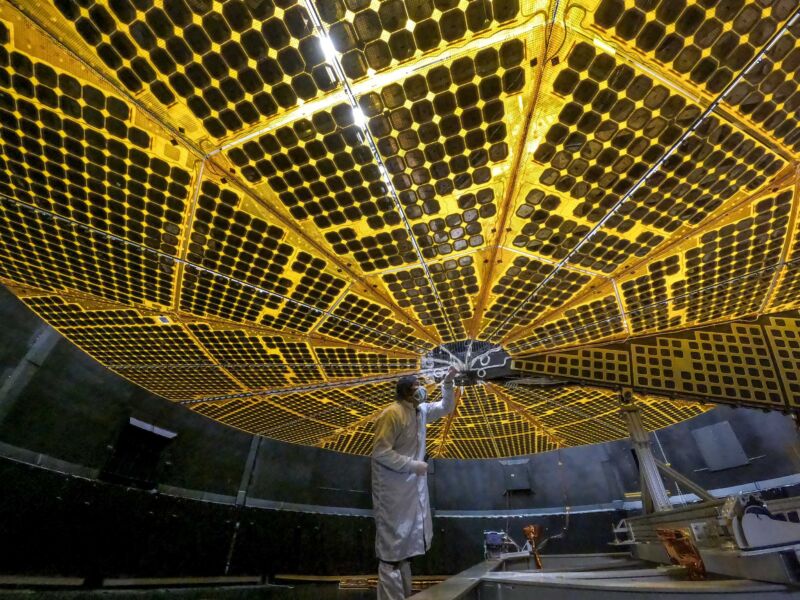

Lucy’s solar panel hasn’t latched—a problem for a mission powered by the Sun
source link: https://arstechnica.com/science/2021/10/lucys-solar-panel-hasnt-latched-a-problem-for-a-mission-powered-by-the-sun/
Go to the source link to view the article. You can view the picture content, updated content and better typesetting reading experience. If the link is broken, please click the button below to view the snapshot at that time.

Lucy got some 'splaining to do —
Lucy’s solar panel hasn’t latched—a problem for a mission powered by the Sun
"The team is analyzing data to determine next steps."
Eric Berger - 10/18/2021, 2:17 PM

NASA's Lucy spacecraft launched safely into space early on Saturday morning from Florida, but after the deployment of its two large solar arrays, one of them failed to latch properly.
Combined, the two solar arrays have a collecting area of 51 square meters. Such large arrays are necessary because the spacecraft will spend much of its 12-year journey about five times the distance of the Earth from the Sun. Lucy's solar panels can only generate about 3 percent of the energy at a Jovian distance than they can at Earth's orbit around the Sun.
The solar panels are critical. Mission scientists say that Lucy will travel farther from the Sun, for a longer time, than any previous solar-powered spacecraft.
According to NASA, as of this weekend, both arrays were providing power to Lucy and charging batteries on the spacecraft. "In the current spacecraft attitude, Lucy can continue to operate with no threat to its health and safety," the agency said in a blog post. But it is not yet clear how the latching issue will affect long-term operations and maneuvering of the 1.5-ton spacecraft.
Engineers from NASA and the spacecraft's primary contractor, Lockheed Martin, are actively working on the issue.
Advertisement"NASA’s Lucy Mission is safe and stable," the agency's chief of scientific exploration, Thomas Zurbuchen, said Sunday on Twitter. "The two solar arrays have deployed, but one may not be fully latched. The team is analyzing data to determine next steps. This team has overcome many challenges already, and I am confident they will prevail here as well."
A senior official at NASA said there was "concern" about the spacecraft but that the mission's leaders were "pretty optimistic" about being able to address the issue. They expect to learn more this week about the problem and to identify potential fixes.
Lucy, bound for the main asteroid belt and then the Trojan asteroids in Jupiter's orbit, is in an escape orbit from Earth and beyond any hope of repair by an intervening spacecraft.
The $981 million mission is planned to fly an extremely complex trajectory over the span of a dozen years. The spacecraft will swing by Earth a total of three times for gravitational assists as it visits a main-belt asteroid, 52246 Donaldjohanson, and will subsequently fly by eight Trojan asteroids that share Jupiter's orbit around the Sun.
Recommend
-
 13
13
Lucy D’Agostino McGowanJupyterCon 2020 keynote speaker announcement...
-
 18
18
AboutIn the near future, androids have become the way of the norm. Emotionless husks of metal have become a part of human society, much to the dismay of the boy. The robot he found at the dumpsite though, this one was...
-
 15
15
Bitcoin Miner Funds $250 Million Solar Panel Project in USA – Trustnodes700,000 solar panels (pictured) that can power 40,600 single family homes are to be rolled out in Butte, Montana, pending zoning permits. The project is by Madi...
-
 4
4
Home ...
-
 7
7
In the sky with diamonds — With solar arrays now operational, Lucy’s got some shimmering to do We still have to wait three years before the first asteroid flyby....
-
 7
7
Tim Cook firmly latched Apple onto China’s CCP teat. What’s his plan for weaning it off? Wednesday, November 2, 2022 11:17 pmThursday, November 3, 2022
-
 9
9
A quick look at decision supervision by Lucy Spence BY Ian Hayn...
-
 8
8
News » Topics »
-
 5
5
SpaceflightThis Is Fine: NASA Pauses Attempts to Fix Lucy's Pesky Solar ArrayNASA says the circular solar array is 98%...
-
 11
11
Lucy Liu Plays 'The Pirate Queen' In Early 2024 On Quest & PC VR Skip to content Pleas...
About Joyk
Aggregate valuable and interesting links.
Joyk means Joy of geeK